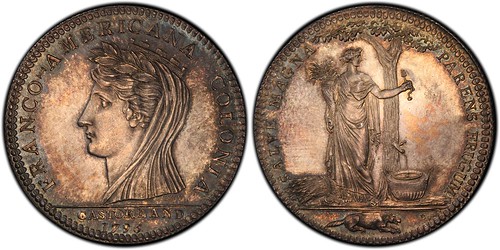
PREV ARTICLE
NEXT ARTICLE
FULL ISSUE
PREV FULL ISSUE
HELP SOUGHT FOR CENSUS OF CASTORLAND JETONS
Recent subscriber Chester Sullivan is compiling A Descriptive Census of Castorland Jetons, and could use some assistance from
E-Sylum readers. -Editor
 Image from CoinFacts.com A Descriptive Census of Castorland Jetons The census aims to establish a data base of original-die Castorland jetons which are French (non-royal) jetons, a private commercial issue commissioned by The New York Company (La Compagnie de New York). Designed and engraved by Benjamin Duvivier, former Engraver General of the French mint, the jetons are all dated 1796. Their issuance was authorized by Title Five, Article nine of the company’s charter (Constitution) which became effective on the 28th of June 1793. They were struck on a fee basis at the Paris mint (La Monnaie). The New York Company owned a large tract of development land in upstate New York which the jetons refer to by name in exergue on the obverse, CASTORLAND. The obverse legend reads FRANCO-AMERICANA COLONIA, a further reference to the company’s New York land venture, and the coin’s reverse iconography endorses the land venture with positive images: a cornucopia symbolizing fruitfulness, a beaver (castor in French) symbolizing the fur trade, and a maple tree promising maple sugar. Information can be taken from various sources. The most reliable source is a raw coin in hand, available for study with magnification. The next best source is a “holdered” coin in hand. Even with the new edge-view holders a determination of flan thickness and edge milling and edge marks is unreliable. The next best source of information is a digitalized photograph like those in the Heritage Auctions archive. And the least reliable source is information taken from sale catalogues. Caution should be exercised when considering the written descriptions of coins offered for sale. Both the seller and the seller’s agent have an interest in presenting the coin in its most positive light. Historical statements about Castorland jetons vary widely, and many are outright fanciful. The four basic identifiers are: metal, flan thickness, die alignment, and edge milling. In addition to those identifiers the census uses four incidental identifiers. The first of which is die etching, the second is flan drift, the third is metal flow, and the fourth is evidence of the reverse die break at the S of PARENS, noted as S bulge and S break.
For more information on the project, or to contribute images or information, contact Chester at csull@ku.edu. -Editor
Wayne Homren, Editor The Numismatic Bibliomania Society is a non-profit organization promoting numismatic literature. See our web site at coinbooks.org. To submit items for publication in The E-Sylum, write to the Editor at this address: whomren@gmail.com To subscribe go to: https://my.binhost.com/lists/listinfo/esylum All Rights Reserved. NBS Home Page Contact the NBS webmaster 
|